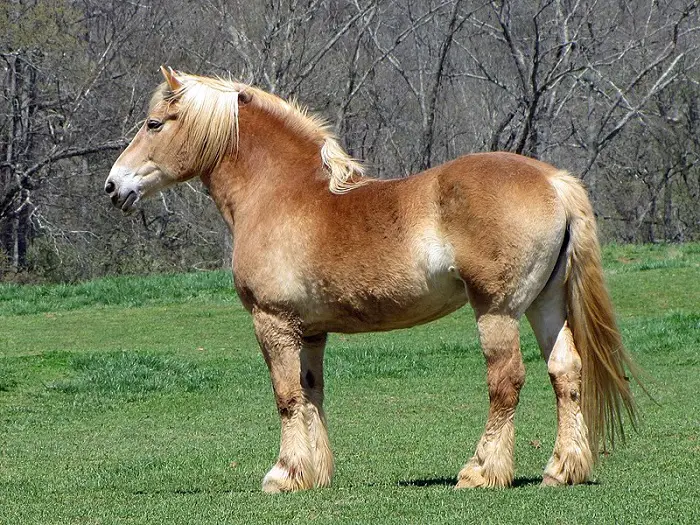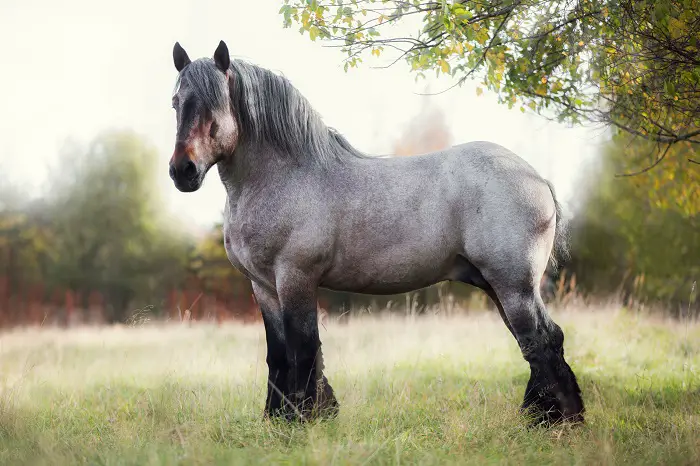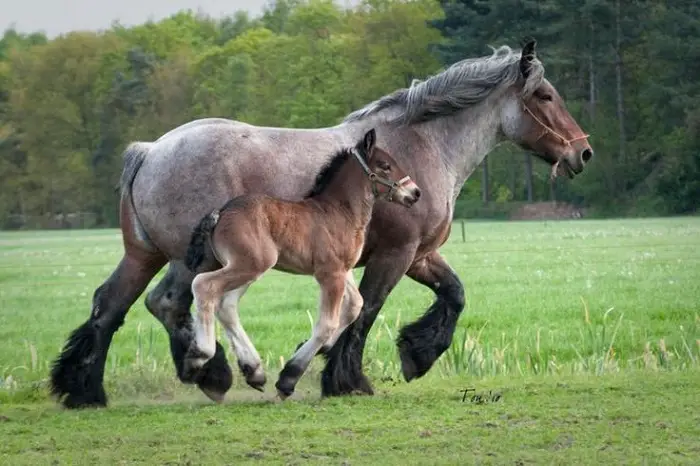The Brabant horse is a draft horse breed that originated in the Brabant region of Belgium. It is also known as the Belgian Heavy Draft, Belgian Brabant, or simply Brabant. The breed was heavily used in the late 19th and early 20th centuries for agricultural purposes, but their numbers declined sharply with the advent of mechanization. Today, the Brabant horse is considered a rare breed, and efforts are being made to preserve and promote it.
Origin and History of Brabant Horse
The Brabant horse breed originated in the Brabant region of Belgium, located in the central part of the country. The breed’s ancestry can be traced back to the medieval period when draft horses were used for agriculture and transportation.
During the 19th century, the Brabant horse was selectively bred for size, strength, and workability, with breeders focusing on developing a horse that could handle heavy farm work and transportation tasks. The breed was also crossed with other draft breeds, such as the Shire and the Suffolk Punch to improve its characteristics.
The Brabant horse became immensely popular in the late 1800s and early 1900s, both in Belgium and abroad. They were used extensively for agriculture, transportation, and industry and were exported to many countries, including the United States, Canada, and South America.
However, the advent of mechanization and the decline of traditional farming practices led to a sharp decline in the breed’s population. By the mid-20th century, the Brabant horse was on the verge of extinction, with only a few hundred animals remaining.
Efforts were made to preserve the breed, and in 1982, the Belgian Draft Horse Corporation was founded to promote the Brabant horse and other Belgian draft breeds. The Brabant horse is still rare, but its population has stabilized. It is slowly increasing, thanks to conservation efforts and the breed’s versatility and adaptability to various uses.
Physical Features of Belgian Brabant Horse
The Belgian Brabant horse, also known simply as the Brabant, is a heavy draft horse breed known for its impressive size, strength, and workability. Here are some of its physical features:
- Size: Brabant horses are huge, standing between 16 and 18 hands (64 to 72 inches) at the shoulder. They can weigh up to 2,000 pounds, making them one of the heaviest horse breeds in the world.
- Build: The Brabant horse has a muscular and compact build with a broad chest, short but powerful legs, and well-developed hindquarters. Their bodies are covered in dense, wavy hair, which helps protect them from cold weather and harsh conditions.
- Head and Neck: The Brabant horse has a large head with a broad forehead, strong jaws, and expressive eyes. Their necks are short and powerful, with a pronounced crest.
- Coat: Brabant horses have thick, heavy coats in various colors, including bay, chestnut, black, and gray. Their manes and tails are also thick and flowing.
- Temperament: Brabant horses are known for their gentle and docile temperament, making them easy to handle and train. They are also known for their willingness to work and ability to handle heavy loads and demanding tasks.
Overall, the Brabant horse is a unique and powerful breed well-suited for various purposes, from agricultural work to driving and riding. Its strength, size, and temperament make it popular for horse enthusiasts and farmers.
Height and Weight of Brabant Horse
The Brabant horse is a large draft horse breed known for its impressive size and strength. On average, Brabant horses stand between 16 and 18 hands (64 to 72 inches) at the shoulder and can weigh up to 2,000 pounds (907 kg).
The height and weight of a Brabant horse can vary depending on factors such as age, gender, and genetics. Male Brabant horses are typically larger and heavier than females, with some stallions weighing up to 2,500 pounds (1,134 kg).
Colors and Markings of Brabant Belgian Horse
The Belgian Heavy Draft, or the Brabant, can come in various colors and markings. Here are some of the most common colors and markings of the Brabant horse:
- Bay: A reddish-brown body with black points (mane, tail, and lower legs).
- Chestnut: A reddish-brown body with matching points.
- Black: A solid black coat.
- Gray: A coat that is a mix of black and white hairs.
- Roan: A coat that mixes white and other colors, such as bay or chestnut.
- Pinto: A coat characterized by large, irregular patches of white and another color.
In addition to their coat colors, Brabant horses may also have various markings, such as a blaze (a white stripe down the center of the face), a star (a small white patch on the forehead), or socks (white markings on the lower legs).
Overall, the Brabant horse’s coat colors and markings vary widely, but their muscular build and impressive size make them a unique breed easily recognizable.
The Behavior of Brabant Horse
The Brabant horse is known for its gentle, docile temperament and willingness to work, making it a popular choice for agricultural work, driving, and riding. Here are some common behaviors of the Brabant horse:
- Calm and Docile: The Brabant horse is known for its calm, easy-going temperament. They are not easily spooked and are comfortable in various environments, making them an ideal choice for beginner riders and handlers.
- Hardworking: The Brabant horse was initially bred for agricultural work and is still highly valued for strength and workability. They are naturally inclined towards pulling heavy loads and are well-suited for plowing fields, hauling heavy loads, and pulling carts and carriages.
- Willingness to Learn: The Brabant horse is intelligent and willing to learn, making it easy to train for various tasks. They respond well to positive reinforcement training methods and can be trained for riding, driving, and even jumping.
- Social: The Brabant horse is a social animal and enjoys being around other horses and humans. They thrive in a herd environment and enjoy interacting with their handlers.
The Brabant horse’s gentle temperament, willingness to work, and friendly nature make them an ideal breed for various tasks. They are valued for their strength and workability, as well as their easy-going nature and willingness to learn.
Feed and Nutrition of Belgian Draft Brabant Horse
Belgian Draft Brabant horses are large, heavy draft horses that require a balanced diet to maintain their health, strength, and energy. Here are some general guidelines for feeding and nutrition for Belgian Draft Brabant horses:
- Forage: High-quality forage should comprise most of a Brabant horse’s diet. This can include hay, pasture, and silage. Brabant horses require a minimum of 1.5% to 2% of their body weight in forage per day.
- Concentrates: Besides forage, Brabant horses may require concentrates such as grains and commercial feeds to meet their energy and nutrient requirements. However, the concentration amount should be limited based on the horse’s workload, age, and body condition.
- Water: Brabant horses always require access to clean, fresh water. A mature horse may drink up to 10 gallons of water per day.
- Vitamins and Minerals: Brabant horses require a balanced intake of vitamins and minerals to maintain their health. This can be achieved through a balanced diet or the use of supplements.
- Feeding Schedule: Brabant horses should be fed regularly, with small meals throughout the day rather than one large meal. This can help prevent digestive problems such as colic.
- Weight Management: Brabant horses are prone to obesity, so monitoring their body condition and adjusting their diet is essential. An overweight Brabant horse may require a lower-calorie diet and increased exercise.
Overall, the key to feeding and nutrition for a Belgian Draft Brabant horse is to provide a balanced diet that meets their energy and nutrient requirements while preventing obesity and other health problems. Consultation with a veterinarian or equine nutritionist can help develop a feeding plan appropriate for the individual horse.
Care and Health of Belgian Brabant Draft
Proper care and maintenance are essential to keeping a Belgian Brabant horse healthy, happy, and performing at its best. Here are some general guidelines for the care and health of a Belgian Brabant horse:
- Regular Veterinary Care: Regular check-ups with a veterinarian are essential to maintaining a Brabant horse’s health. They should receive an annual wellness exam, vaccinations, and parasite control.
- Grooming: Regular grooming helps maintain the Brabant horse’s coat, skin, and overall health. Daily grooming can help prevent skin problems, such as rain rot, and promote good circulation.
- Exercise and Turnout: Brabant horses should have regular access to turnout and exercise to promote good physical and mental health. They require daily exercise to maintain their strength and stamina.
- Foot Care: Proper foot care is essential for a Brabant horse’s overall health and performance. Regular hoof trimming and shoeing by a qualified farrier is essential to prevent lameness and other foot problems.
- Dental Care: Regular dental care, such as floating (filing down) the teeth, is essential to prevent dental problems and ensure proper digestion.
- Nutrition: A balanced diet that meets the Brabant horse’s energy and nutrient requirements is essential to maintain good health. The feed should be adjusted based on the horse’s age, workload, and body condition.
- Parasite Control: Regular deworming is essential to prevent parasite infestations that can lead to health problems such as weight loss, anemia, and colic.
Overall, the care and health of a Belgian Brabant horse require attention to many factors, including veterinary care, grooming, exercise, nutrition, and parasite control. By providing proper care and attention, Brabant horses can live long, healthy lives and perform at their best.
Diseases of Brabant Draft Horse
Like all horse breeds, Belgian Brabant horses are susceptible to various diseases and health problems. Here are some common diseases and health issues that can affect Brabant horses:
- Lameness: Lameness can be caused by various factors, including injury, arthritis, and hoof problems. Regular foot care, exercise, and monitoring can help prevent and manage lameness in Brabant horses.
- Colic: Colic is a digestive disorder caused by various factors, including feeding practices and management. Brabant horses should be fed a balanced diet, provided with plenty of fresh water, and have access to regular exercise and turnout to help prevent colic.
- Respiratory Problems: Brabant horses may be susceptible to respiratory issues such as allergies and infections. Good ventilation, dust-free bedding, and regular veterinary care can help prevent respiratory problems in Brabant horses.
- Parasites: Brabant horses can be susceptible to internal and external parasites, such as worms, ticks, and lice. Regular deworming and good hygiene practices can help prevent parasite infestations.
- Equine Metabolic Syndrome (EMS): EMS is a metabolic disorder that can affect overweight or obese horses, causing insulin resistance and other health problems. Proper nutrition and regular exercise can help prevent and manage EMS in Brabant horses.
- Equine Herpesvirus (EHV): EHV is a viral infection that can cause respiratory and neurological symptoms in horses. Good biosecurity practices like quarantine procedures and regular vaccinations can help prevent EHV outbreaks.
Regular veterinary care, proper nutrition, exercise, and good management practices can help prevent and manage many health issues affecting Brabant horses. Early detection and treatment of health problems are essential to ensure the best possible outcome for the horse’s health and well-being.
Unique Features of Brabant Horse
The Belgian Brabant horse is a draft horse breed known for its strength, power, and gentle disposition. Here are some special features that make Brabant horses unique:
- Muscular Build: Brabant horses are heavily muscled and have the large, robust body that makes them well-suited for heavy work, such as plowing fields and pulling wagons.
- Calm Temperament: Brabant horses are known for their calm, gentle temperament, making them a popular choice for novice riders or as family horses.
- Feathered Feet: Brabant horses have feathered feet, which are long hairs that grow around the hooves and legs, adding to their distinctive appearance.
- High Energy: Despite their calm demeanor, Brabant horses have high energy levels and require regular exercise and turnout to maintain their physical and mental well-being.
- Long Lifespan: Brabant horses have a longer lifespan than many other horse breeds, with some living up to 30 years or more.
- Endurance: Brabant horses are known for their endurance, making them well-suited for long fieldwork hours.
Overall, the Brabant horse is a powerful and gentle breed with a distinctive appearance and high energy levels. Their unique features make them well-suited for heavy work and an excellent choice for those seeking a calm and reliable horse for riding or driving.
Uses of Belgian Brabant Draft Horse
The Belgian Brabant horse is primarily used for draft work, such as plowing fields, hauling heavy loads, and logging. They are well-suited for these types of work due to their muscular build, strength, and endurance. In addition to draft work, Brabant horses are also used for:
- Carriage Driving: Brabant horses are often used for carriage driving, thanks to their gentle temperament and robust build.
- Show Competitions: Brabant horses are often showcased in shows and competitions due to their distinctive appearance, including their feathered feet and large size.
- Riding: Although primarily used for draft work, Brabant horses can also be ridden for pleasure or work, thanks to their calm and gentle temperament.
- Therapeutic Riding: Brabant horses are sometimes used in therapeutic riding programs due to their gentle nature and calm temperament.
Overall, the Belgian Brabant horse is a versatile breed primarily used for draft work, driving, riding, and therapeutic programs. Their gentle nature, endurance, and strength make them popular for various applications.
Brabant Horse For Sale
If you’re interested in purchasing a Belgian Brabant horse, several options are available. Here are some ways to find Brabant horses for sale:
- Online Horse Marketplaces: There are many online horse marketplaces where you can search for Brabant horses for sale, including HorseClicks, Equine.com, and DreamHorse.com.
- Breeders: You can also contact Brabant horse breeders directly to inquire about available horses for sale. A quick internet search can help you locate breeders in your area.
- Auctions: Brabant horses may also be available at horse auctions. Please do your research and inspect the horse thoroughly before purchasing it at an auction.
- Equine Rescue Organizations: Some equine rescue organizations may have Brabant horses available for adoption or sale.
When purchasing a Brabant horse, it’s essential to work with a reputable seller and to thoroughly inspect the horse before making a purchase. Look for a horse with a calm temperament, good conformation, and soundness. Consider working with a veterinarian to perform a pre-purchase exam to ensure the horse is healthy and free of medical issues.
Final Talk on Brabant Horse
The Belgian Brabant horse is a magnificent breed known for its strength, endurance, and gentle nature. Initially bred for heavy draft work, this breed has become increasingly popular for driving, riding, and therapeutic programs.
With its muscular build and powerful physique, the Brabant horse is a reliable worker that can handle the most demanding jobs. At the same time, the breed’s calm temperament and affectionate nature make it a popular choice for riders and drivers of all experience levels.
The Brabant horse is also renowned for its distinctive appearance, including its feathered feet, broad chest, and short, powerful neck. Its unique physical features and gentle nature make the Brabant horse a true standout in the world of equine breeds.
Overall, the Belgian Brabant horse is a breed that offers beauty and brawn, making it a popular choice for many equine enthusiasts. Whether you’re looking for a reliable workhorse, a driving partner, or a gentle companion, the Brabant horse is an excellent choice.


